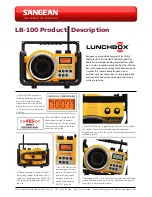
39
Northtstar
Explorer VHF Series: 710US, 710EU
Operation and Installation Manual
d.
The frequencies in this Table may also be used for radiocommunications on inland waterways in accord-
ance with the conditions specifi ed in No. 5.226. – 56 – 62238 IEC:2003(E)
e.
Administrations having an urgent need to reduce local congestion may apply 12,5 kHz channel interleav-
ing on a non-interference basis to 25 kHz channels, provided:
– Recommendation ITU-R M.1084-2 shall be taken into account when changing to 12,5 kHz channels;
– it shall not aff ect the 25 kHz channels of the present Annex maritime mobile distress and safety fre-
quencies, especially the channels 06, 13, 15, 16, 17, and 70, nor the technical characteristics mentioned
in Recommendation ITU-R M.489-2 for those channels;
– implementation of 12,5 kHz channel interleaving and consequential national requirements shall be
subject to prior agreement between the implementing administrations and administrations whose ship
stations or services may be aff ected.
Specifi c notes
f.
The frequency 156,300 MHz (channel 06) (see No. 51.79 and Appendices 13 and 15) may also be used for
communication between ship stations and aircraft stations engaged in coordinated search and rescue
operations. Ship stations shall avoid harmful interference to such communications on channel 06 as well
as to communications between aircraft stations, ice-breakers and assisted ships during ice seasons.
g. Channels 15 and 17 may also be used for on-board communications provided the eff ective radiated
power does not exceed 1 W, and subject to the national regulations of the administration concerned
when these channels are used in its territorial waters.
h. Within the European Maritime Area and in Canada, these frequencies (channels 10, 67, 73) may also
be used, if so required, by the individual administrations concerned, for communication between ship
stations, aircraft stations and participating land stations engaged in coordinated search and rescue and
anti-pollution operations in local areas, under the conditions specifi ed in Nos. 51.69, 51.73, 51.74, 51.75,
51.76, 51.77 and 51.78.
i.
The preferred fi rst three frequencies for the purpose indicated in Note a) are 156,450 MHz (channel
09),156,625 MHz (channel 72) and 156,675 MHz (channel 73).
j.
Channel 70 is to be used exclusively for digital selective calling for distress, safety and calling.
k.
Channel 13 is designated for use on a worldwide basis as a navigation safety communication channel,
primarily for intership navigation safety communications. It may also be used for the ship movement
and port operations service subject to the national regulations of the administrations concerned.
l.
These channels (AIS 1 and AIS 2) will be used for an automatic ship identifi cation and surveillance system
capable of providing worldwide operation on high seas, unless other frequencies are designated on a
regional basis for this purpose.
m. These channels may be operated as single frequency channels, subject to special arrangement between
interested or aff ected administrations. (WRC-2000)
n. The use of these channels (75 and 76) should be restricted to navigation-related communications only
and all precautions should be taken to avoid harmful interference to channel 16, e.g. by limiting the
output power to 1 W or by means of geographical separation.
o. These channels may be used to provide bands for initial testing and the possible future introduction
of new technologies, subject to special arrangement between interested or aff ected administrations.
Stations using these channels or bands for the testing and the possible future introduction of new
technologies shall not cause harmful interference to, and shall not claim protection from, other stations
operating in accordance with Article 5. (WRC-2000)
















































